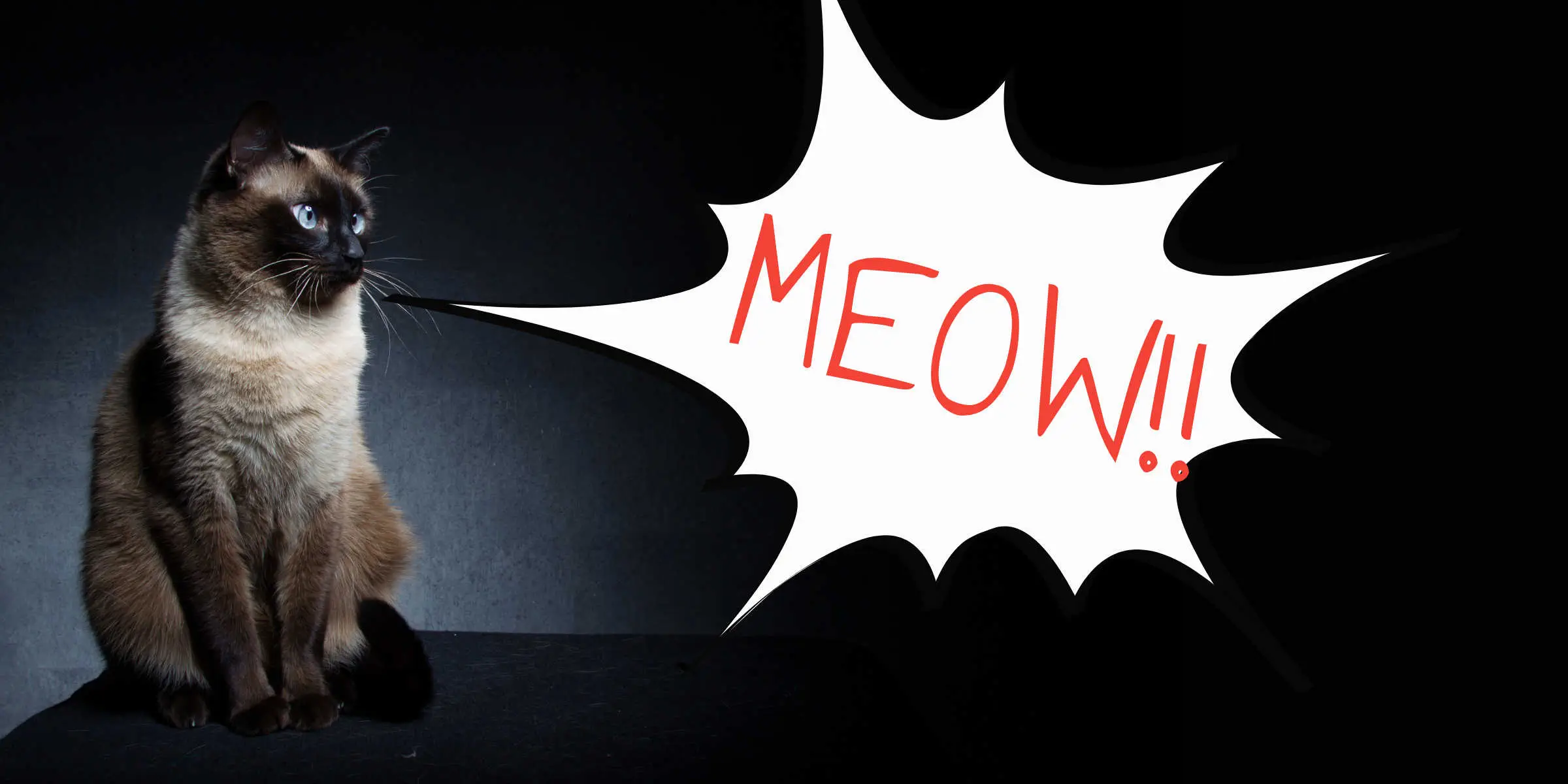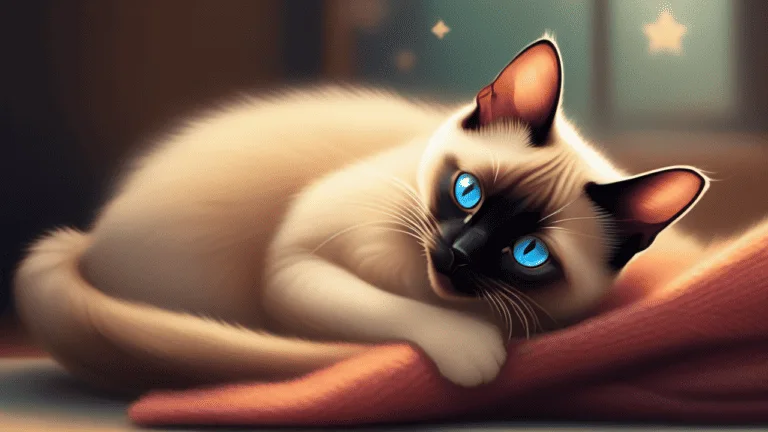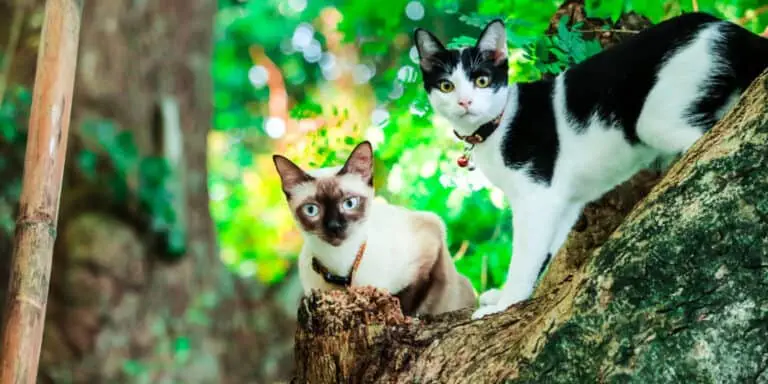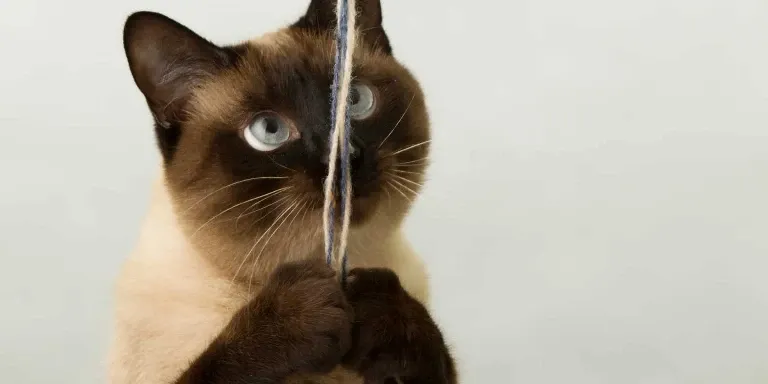The Best Fluffy Pancakes recipe you will fall in love with. Full of tips and tricks to help you make the best pancakes.

As you gaze into the piercing blue eyes of a Siamese cat, you may find yourself captivated by their unmistakable vocalizations. The sound of their meows, yowls, and chirps can be both charming and incessant. But have you ever wondered why Siamese cats are so vocal? What is the reason behind their unique communication style?
Siamese cats are so vocal because they are highly social animals. They’re known for their distinctive loud meows and adaptable nature, and like to communicate with their owners. Siamese cats also have a strong need for attention and will let you know when they want it by being vocal.
In this article, we will explore the history, intelligence, and social nature of Siamese cats to uncover the answer to this intriguing question.
Siamese cats have a rich history that dates back to ancient Siam (now known as Thailand). They were revered as sacred animals and were often kept by royalty. It was believed that their unique vocalizations were a form of communication between the cats and their masters. This belief was so strong that when a Siamese cat was given as a gift, it was believed to bring good luck and prosperity to the recipient.
Today, Siamese cats are a popular breed around the world, known for their striking appearance and their vocal tendencies. So, what makes Siamese cats so talkative? Let’s find out.
The History of Siamese Cats
You’re probably wondering why Siamese cats have such a rich history – they’ve been around for centuries and were even considered sacred in ancient Siam! The origins of Siamese cats can be traced back to the ancient kingdom of Siam, which is now known as Thailand.
These cats were highly valued by the royalty and were believed to bring good luck and protection. Siamese cats were also believed to have spiritual powers and were often used in religious ceremonies. They were even given offerings of food and were treated with great respect.
Their unique appearance and vocal nature made them stand out from other cats, and they quickly became a symbol of royalty and status. The cultural significance of Siamese cats is still evident today, as they are one of the most popular cat breeds worldwide.
Their beauty, intelligence, and vocal nature have captured the hearts of people around the world. It’s clear that Siamese cats have a fascinating history that continues to intrigue and delight cat lovers everywhere.
The Intelligence of Siamese Cats
So you want to learn more about the intelligence of Siamese cats? Well, you’re in luck because these cats are known for their exceptional problem-solving skills. They often figure out how to open doors or cabinets.
Additionally, Siamese cats are highly trainable. They can learn a variety of tricks, such as playing fetch or jumping through hoops. Their intelligence and trainability make them great companions for those looking for a smart and engaging pet.
Problem-Solving Skills
With their constant meows and chirps, have you ever wondered if Siamese cats have superior problem-solving skills? The answer is yes.
Siamese cats have been shown to have remarkable problem-solving skills, which are believed to be due to their high level of intelligence. This breed of cats can easily learn new skills, and they can quickly adapt to new environments. They’re typically curious cats, which means they enjoy exploring their surroundings to learn more about the world around them.
Improving problem-solving skills in Siamese cats can be achieved through behavioral modification techniques. These techniques involve positive reinforcement, where good behavior is rewarded with treats or affection. This method allows the cat to associate positive experiences with good behavior, which helps them learn faster.
Another way to improve problem-solving skills is by providing Siamese cats with interactive toys. These toys are designed to challenge the cat’s mind, allowing them to exercise their problem-solving skills and enhance their cognitive abilities.
With the right training and attention, Siamese cats can become excellent problem solvers, making them great companions for those who desire intelligent and curious pets.
Ability to Learn Tricks
It’s amazing how quickly felines can pick up new tricks when given the right training and attention. Siamese cats, in particular, are known for their ability to learn tricks and perform them with precision.
Training techniques for these cats can vary, but it’s important to start with the basics and build up gradually. Simple commands like sit, stay, and come can be taught using positive reinforcement, such as treats and praise, and gradually progressing to more complex tricks like high-fiving, jumping through hoops, and even playing dead.
When it comes to training Siamese cats, it’s important to keep in mind their high energy levels and active nature. They love to play and interact with their owners, so incorporating tricks that allow them to use their natural abilities, like jumping and climbing, can be very rewarding for both cat and owner.
Some types of tricks that Siamese cats can excel in include agility courses, fetch, and even leash training. With patience, dedication, and a willingness to learn, Siamese cats can become fantastic trick performers, showcasing their intelligence and love of play.
Social Nature of Siamese Cats
Siamese cats are known for their social nature, and they thrive on human interaction, with some even following their owners from room to room. According to a study conducted by the University of California, Davis, Siamese cats are significantly more interactive with humans than other breeds. This socialization pattern is one of the reasons why Siamese cats are so vocal. They use vocalizations as a means of communication to express their needs and emotions to their human companions.
Here are four ways in which Siamese cats’ social nature influences their vocalization patterns:
- Siamese cats meow to greet their owners. When you come home, your Siamese cat might meow loudly and persistently to greet you. This is because they are happy to see you and want to communicate their excitement.
- Siamese cats meow to demand attention. If your Siamese cat wants attention, they might meow incessantly until they get it. This is because they thrive on human interaction and want to be close to their owners as much as possible.
- Siamese cats meow to express discomfort. If your Siamese cat is uncomfortable or in pain, they might meow loudly and persistently to let you know. This is because they trust their owners and want them to help alleviate their discomfort.
- Siamese cats meow to express hunger. If your Siamese cat is hungry, they might meow loudly and persistently until they are fed. This is because they are social animals and rely on their owners for sustenance.
Siamese cats’ social nature is the reason behind their vocalization patterns. They use vocalizations as a means of communication to express their needs and emotions to their human companions. As a Siamese cat owner, it’s important to understand their socialization patterns to better understand their vocalizations and provide them with the care and attention they need.
Siamese Cat Vocalization
You can hear the melodious sounds of a Siamese cat’s communication with their human companion, expressing their needs and emotions through various vocalizations. As a Siamese cat owner, you might have noticed that they are more vocal than other cat breeds. This is because they have a unique vocalization system that is influenced by their breed characteristics.
Siamese cats are known for their social nature and strong attachment to their human companions, which makes them more vocal. They meow to communicate their needs, emotions, and even their opinions. Siamese cats have a wide range of vocalizations, from soft and sweet to loud and demanding. They can also mimic human sounds, such as crying or laughing, which makes them even more endearing.
Meowing behavior analysis reveals that Siamese cats meow for various reasons, including hunger, thirst, boredom, and loneliness. They also meow to seek attention, express their affection, and to alert their human companions of any danger.
Overall, Siamese cat vocalization is a unique and fascinating aspect of their breed characteristics, which makes them stand out from other cat breeds. By understanding their vocalization system, you can better communicate with your Siamese cat and strengthen your bond with them.
Communication with Owners
Feel the strong bond between you and your feline companion as you understand their complex communication system. Siamese cats are known for their talkative nature and use a wide range of sounds to convey their emotions and needs, from meows to purrs, growls, and even chirps. Understanding their body language and vocal cues is key to building a strong bond with your Siamese cat.
Bonding techniques can help establish a deeper connection with your Siamese companion. Spend quality time with them, offer treats, and play regularly. This will not only strengthen your bond but also help you understand their communication patterns better. Siamese cats are social and thrive on human interaction. Communication plays an essential role, so pay attention to their vocalizations and body language.
Understanding body language is crucial when communicating with Siamese cats. They express themselves through posture, tail movements, and facial expressions. For instance, a cat with an arched back and bristled fur is indicating aggression or fear. A cat with a relaxed body posture and a slowly swishing tail is content and happy. Paying attention to these cues helps you understand your cat’s emotional state and respond accordingly.
Establish a strong bond with your Siamese cat and communicate effectively by understanding their unique communication system.
Vocalization as a Sign of Health Issues
As an owner of a Siamese cat, it’s important to keep an ear out for changes in their vocalization.
This is because vocalization can be a sign of various health issues that commonly affect Siamese cats.
If you notice changes in your cat’s meows or yowls, it may be a symptom of a health problem that requires attention from a veterinarian.
Common Health Problems in Siamese Cats
Siamese cats are prone to health issues such as respiratory problems, dental issues, and amyloidosis. These health problems often stem from their breeding lineage and genetic predispositions. As a responsible pet owner, it’s important to be aware of these health concerns to ensure that your cat receives proper care.
To better understand the common health problems in Siamese cats, listed below are four key issues to be aware of:
- Respiratory problems: Siamese cats are known to have narrow nasal passages, making them more susceptible to respiratory infections and breathing difficulties.
- Dental issues: Due to their narrow jaw structure, Siamese cats may experience dental overcrowding or misalignment, leading to dental problems such as tartar buildup or gum disease.
- Amyloidosis: This is a genetic disorder that can affect Siamese cats, resulting in the buildup of amyloid protein in various organs, leading to organ failure.
- Gastrointestinal problems: Siamese cats can be prone to gastrointestinal issues such as vomiting or diarrhea, which may be caused by food allergies or intolerances.
By being aware of these health concerns, you can take proactive steps to prevent and manage any potential health problems in your Siamese cat. Regular veterinary check-ups, a healthy diet, and proper dental care can help ensure that your furry feline companion stays happy and healthy.
Changes in Vocalization as a Symptom
Now that you know about some common health problems that Siamese cats may experience, it’s important to keep an eye out for any changes in their vocalization. Siamese cats are known for being very vocal, but excessive meowing or yowling could be a sign of a health issue. Understanding feline behavior and knowing what to look for can help you identify if your Siamese cat is in distress.
If you notice a sudden increase in your Siamese cat’s vocalization, it’s important to take them to the vet to rule out any health problems. Once a health issue has been ruled out, there are treatment options for excessive vocalization. These may include training techniques, environmental changes, or medication.
Your veterinarian can help you determine the best course of action to help your Siamese cat feel more comfortable and reduce their excessive vocalization. Remember to always consult with your veterinarian for any changes in your cat’s behavior or health.
Tips for Dealing with Talkative Siamese Cats
If you’re dealing with a talkative Siamese cat, there are a few tips that can help. Positive reinforcement training can be effective in reducing excessive vocalization.
Providing adequate attention and playtime can also help keep your Siamese cat content and less likely to meow incessantly. By implementing these strategies, you can enjoy a quieter and more peaceful coexistence with your chatty feline friend.
Positive Reinforcement Training
Using positive reinforcement training techniques, you can effectively train your Siamese cat to communicate with you. Clicker training is one popular method that involves using a clicker and treats to reward your cat for exhibiting desired behaviors.
Behavioral modification is another technique that involves changing your cat’s behavior through positive reinforcement. This involves rewarding your cat for good behavior, rather than punishing them for bad behavior. Studies have shown that positive reinforcement training methods are more effective than punishment-based methods in teaching cats to communicate effectively.
Cats trained with positive reinforcement techniques exhibited more vocalization and were more likely to engage with their owners. With patience and consistency, you can teach your Siamese cat to communicate in a way that is both effective and enjoyable for both you and your furry friend.
Providing Adequate Attention and Playtime
To truly connect with your furry Siamese companion and foster a strong relationship, it’s important to give them plenty of attention and playtime throughout the day. Siamese cats are highly social animals that crave interaction and engagement.
By providing them with regular bonding activities, you can help to keep them happy and content. Behavioral training is an essential aspect of providing your Siamese cat with adequate attention and playtime. This type of training can help to establish a strong bond between you and your feline friend, while also teaching them important skills and behaviors.
Some popular training techniques for Siamese cats include clicker training, positive reinforcement training, and interactive playtime. By incorporating these techniques into your daily routine, you can help to ensure that your Siamese cat is getting the attention and stimulation they need to thrive.
Do Siamese Cats’ Vocal and Clingy Nature Have a Connection?
Siamese cats behavior traits are often characterized by their vocal and clingy nature. This unique combination of traits may have a connection rooted in their breeding history and their strong attachment to their owners. Siamese cats are known for their need for attention and company, making them loyal and affectionate companions.
Conclusion
Congratulations! You’re now equipped with knowledge about why Siamese cats are so vocal.
From their history in Thailand, to their intelligence and social nature, Siamese cats have developed a unique way of communicating with their owners through their vocalizations. However, it’s important to note that excessive meowing could also be a sign of health issues such as anxiety or hyperthyroidism.
Now, you may be thinking that dealing with a talkative Siamese cat may be overwhelming, but remember that vocalization is a natural behavior for this breed. Instead of punishing or ignoring your furry friend, try to engage with them through play and interaction.
As a responsible owner, it’s also important to monitor their health and seek veterinary attention if necessary.
In conclusion, understanding the vocal nature of Siamese cats can deepen the bond between you and your feline companion. Embrace their talkative personalities and provide them with the love and care they deserve.








